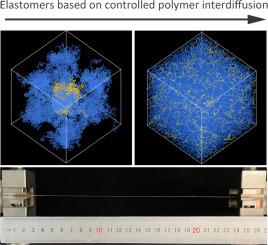基于可控聚合物互扩散和动态硼酯自交联的聚丙烯酸胶乳弹性体
IF 14.3
1区 材料科学
Q1 MATERIALS SCIENCE, MULTIDISCIPLINARY
引用次数: 0
摘要
由于侧链含量相对于总分子量的高比例,聚丙烯酸酯作为弹性体的制造本身就具有挑战性。本研究提出了一种独特的合成聚丙烯酸酯弹性体的策略,将硼酸改性的硬乳胶与二醇改性的软乳胶相结合。硬晶格中的刚性聚合物通过可控的聚合物互扩散和动态硼酸交联有效地锁住软晶格中的柔性聚丙烯酸丁酯链。通过系统地考察颗粒尺寸、刚性聚合物类型和硼酸盐交联分布对胶乳组合的影响,阐明了这种弹性体制备方法的潜在机制。优化这些因素使高可回收性聚丙烯酸酯弹性体的开发成为可能,并且该方法为工业生产提供了可扩展性。本文章由计算机程序翻译,如有差异,请以英文原文为准。

Polyacrylate latex elastomers based on controlled polymer interdiffusion and dynamic boronic ester self-crosslinking
Polyacrylates are inherently challenging to fabricate as elastomers due to their high proportion of side-chain content relative to the overall molecular weight. This study presents a unique strategy for preparing polyacrylate elastomers by integrating boronic-acid-modified hard latices with diol-modified soft latices. The rigid polymers within the hard latices effectively lock the flexible poly(butyl acrylate) chains in the soft latices through controlled polymer interdiffusion and dynamic boronate crosslinking. By systematically examining the effects of particle size, rigid polymer type, and boronate crosslinking distribution in the latex combinations, the underlying mechanism of this elastomer fabrication approach was elucidated. Optimizing these factors enabled the development of highly recoverable polyacrylate elastomers, and the proposed method offers scalability for industrial production.
求助全文
通过发布文献求助,成功后即可免费获取论文全文。
去求助
来源期刊

Journal of Materials Science & Technology
工程技术-材料科学:综合
CiteScore
20.00
自引率
11.00%
发文量
995
审稿时长
13 days
期刊介绍:
Journal of Materials Science & Technology strives to promote global collaboration in the field of materials science and technology. It primarily publishes original research papers, invited review articles, letters, research notes, and summaries of scientific achievements. The journal covers a wide range of materials science and technology topics, including metallic materials, inorganic nonmetallic materials, and composite materials.
 求助内容:
求助内容: 应助结果提醒方式:
应助结果提醒方式:


